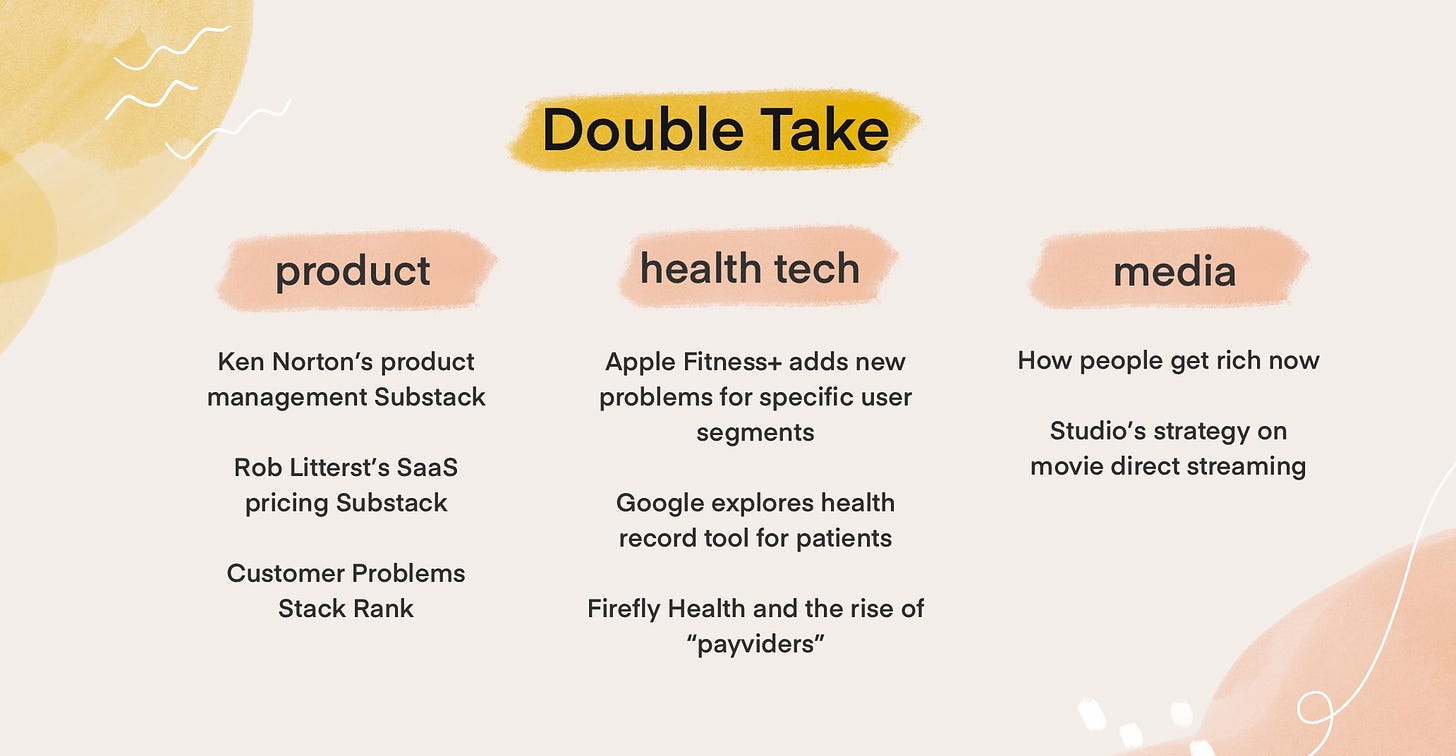Don’t repeat this product failure; the rise of “payvider stacks”; how people get rich now
Hello, welcome to this week’s Double Take on product, health tech, and digital media.
We’re having another round of lock down in Toronto. I’ve been baking lots of cara cara orange scones and pistachio cookies. Let me know if you want recipes :)
Jeff Bezos shares more wisdom in this year’s shareholder letter. The opening theme: create more than you consume. He breaks down the value Amazon created for shareholders, employees, and customers. Amazon is probably one of the companies most worthy to claim that it “saves customers time”.
Okta’s annual Business at work report reveals the fastest growing apps over the pandemic, including a couple of fan-favorite productivity tools that have been supporting remote work: Miro, Figma, and Monday.
The secret to getting people to say yes? Make it as easy as possible by doing the work for them.
✨ Inspiration
What is pertinent is the calmness of beauty, its sense of restraint. It is as though the land knows of its own beauty, its own greatness, and feels no need to shout it.
― The remains of the day
Now onto the regular programming 👇
💻 Product
Product Substack recommendation: Ken Norton’s product reads. Ken’s format is a mix of long form writing focused on a particular theme (eg. Building products at AirBnB) and short form product management nuggets, like this week’s “learning to listen”. Getting comfortable to sit with silence can be powerful in conversations, such as customer interviews. There’s also a great framework about “evidence driven teams”, that is a 2x2 of setting outcome based goals and regularly evaluating and iterating on the results.
Pricing Substack recommendation: Good better best. The latest post shares top 3 SaaS pricing trends in 2021. 1. Use freemium to drive habit formation. For example, Miro’s whiteboarding tool offers a free tier with unlimited users but a limit of 3 boards. The free version gives people time to get used to the product and develop a habit of using it so they’re less likely to churn when they upgrade. 2. Aligning pricing with company vision. Figma’s vision is to spread design beyond designers. This emphasizes the importance of enabling collaboration with different users, which is the driver behind making “viewer” users free across all tiers. 3. Benefits of usage-based pricing. OV published a report showing companies with usage based pricing showing better yoy revenue growth and expansion.
Don’t repeat this product failure story, use the Customer Problems Stack Rank (CPSR) technique. Stripe’s product guru Shreyas shared an illustrative version of this common scenario in B2B SaaS products: building a product that never should’ve been built. Why? It solved a problem, but not THE problem. The solution? CPSR: ask the customer to stack rank their problems, to ensure your product is solving THE most important problem.
📠 Health Tech
Apple Fitness+ adds new programs for specific user segments. Apple Fitness+ launched last December, providing fitness classes connected to the Apple Watch. It’s now adding new workouts specifically for pregnant women, older adults, and beginners. I’ve been using Fitness+ since launch and enjoy it a lot. I noticed Betina, one of the trainers, in yoga classes providing the light version of moves suitable for pregnant women and thought it was a wonderful feature to the class. Consumers like choice but also like being served solutions that feel tailored to them.
Google explores health record tool for patients. Google is recruiting around 300 people for feedback on a new consumer-facing health record tool. Google attempted this in 2008 and shut it down in 2012. Times in the health info space are different now, Apple has been making progress with its health app since 2018, and consumers’ level of acceptance and comfort towards digital health tools are much higher. The anticipation is on the feedback Google will get from consumers this time around.
Firefly Health raise from a16z . There’s a rise of payviders (vertical integrated, groups that both pay for services like insurer, and administer services, like providers). A16z is leading the series B for Firefly health, a virtual-first primary care group. Firefly health entered value based risk contracts with commercial insurers where their tech platform proved better quality and in return received bonus from these contracts. It partners with hospitals to deliver virtual first specialty care, so far demonstrated 2x reduction in monthly cost, improvement in patient outcomes, and a great customer experience (NPS of 91).
📣 Media
How people get rich right now. Paul Graham’s new piece looking at Forbes’ 100 richest people in 2020 compared to 1982. 3/4 of the new fortunes came from starting companies, and 1/4 from investing. The rich from 1982, oil and real estate magnates, won by being great at making deals. Today’s riches win by having great technology. It’s easier to start a company today, because it’s more socially accepted, and more importantly, technology has made it cheaper to start and faster to grow.
Studios’ strategy on direct streaming. Warner Media’s CEO Jason Kilar wants to un-do its decision of streaming new movies on HBO Max on the same day of theatre debut. Starting next year, its biggest movies will debut in theaters first before moving to streaming. Streaming riles up Hollywood.



